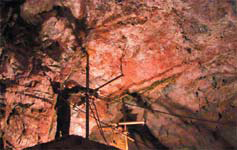
Handy Links
SLAC News Center
SLAC Today
- Subscribe
- Archives: Feb 2006-May 20, 2011
- Archives: May 23, 2011 and later
- Submit Feedback or Story Ideas
- About SLAC Today
SLAC News
Lab News
- Interactions
- Lightsources.org
- ILC NewsLine
- Int'l Science Grid This Week
- Fermilab Today
- Berkeley Lab News
- @brookhaven TODAY
- DOE Pulse
- CERN Courier
- DESY inForm
- US / LHC
SLAC Links
- Emergency
- Safety
- Policy Repository
- Site Entry Form

- Site Maps
- M & O Review
- Computing Status & Calendar
- SLAC Colloquium
- SLACspeak
- SLACspace
- SLAC Logo
- Café Menu
- Flea Market
- Web E-mail
- Marguerite Shuttle
- Discount Commuter Passes
-
Award Reporting Form
- SPIRES
- SciDoc
- Activity Groups
- Library
Stanford
Around the Bay
CDMS Update: Increased Sensitivity for Dark Matter Search

Deep below the snow and ice of Northern Minnesota, Cryogenic Dark Matter Search (CDMS) detectors are performing splendidly. Shielded from cosmic radiation at the bottom of the Soudan mine, the detectors began searching for evidence of dark matter in 2003. Thanks to the hard work of the CDMS team, a collaboration of 13 universities and national labs across the U.S., the sensitivity of these detectors has increased enormously over the past four months.
"We are now surpassing the combined exposure of our previous runs, doubling our expected sensitivity," said Stanford Professor and Co-Spokesperson for CDMS, Blas Cabrera. "This increases our chances of finding a Weakly Interacting Massive Particle," or WIMP.
The CDMS detectors, designed by KIPAC researchers at Stanford and collaborators at other institutions, use superconducting sensors to search for lattice vibrations or heat in germanium and silicon crystals: the signature of a WIMP passing through. WIMPS are thought to be the dominant form of matter in the universe.
CDMS researchers have increased their experiment's sensitivity to WIMPs by increasing the number of detectors and their running times. They will run the detectors continually until at least the end of 2007. The team expects to see a 10-fold increase in the detector sensitivity, compared to experiments in 2003 and 2004 combined.
"This work takes us one step closer to seeing WIMPs," said Cabrera. "But detailed analyses are still required before we can isolate background events from data and have conclusive results."
—Alison Drain, January 18, 2007
Above image: Northern Minnesota's Soudan Mine, where, half a mile underground, a team of KIPAC scientists searches for signatures of dark matter.